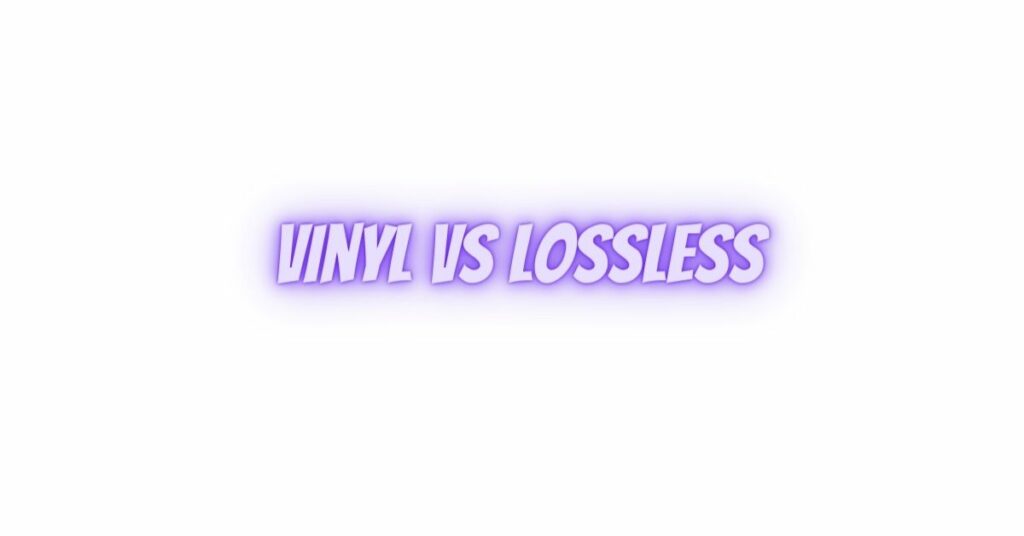In the realm of high-fidelity audio, two formats stand out as paragons of sound quality: vinyl records and lossless digital audio. Vinyl, with its analog warmth and tactile experience, has captivated audiophiles for generations. In contrast, lossless digital audio, represented by formats like FLAC (Free Lossless Audio Codec) and ALAC (Apple Lossless Audio Codec), boasts pristine sound quality. This comprehensive article delves into the nuances of these formats, comparing vinyl and lossless digital audio, and exploring the merits, drawbacks, and unique characteristics of each.
Vinyl Records: The Analog Elegance
Vinyl records have retained a devoted following for their unique charm and auditory allure. Here are some of the distinguishing features of vinyl:
- Analog Warmth: Vinyl captures sound as continuous waveforms, offering a warm, natural, and authentic listening experience. Analog warmth is often associated with vinyl’s organic sound.
- Tactile Engagement: Playing a vinyl record is a multisensory experience. The process of selecting, handling, and placing the stylus on the grooves adds a layer of tactile engagement that is absent in digital formats.
- Collector’s Appeal: Vinyl records, with their history, rarity, and collectible nature, hold an enduring appeal for collectors and enthusiasts.
- Sound Artifacts: Vinyl introduces unique sound artifacts such as pops, clicks, and surface noise. These imperfections are often seen as endearing and add character to the music.
- Limitations: Vinyl records are susceptible to wear and degradation over time. They can also be vulnerable to environmental factors like temperature and humidity.
Lossless Digital Audio: Pure Sonic Fidelity
Lossless digital audio is known for its pristine sound quality and the absence of any data compression or loss. Here are some of the characteristics of lossless digital audio:
- Uncompromised Quality: Lossless digital formats like FLAC and ALAC retain the full audio fidelity of the original recording, ensuring no loss of detail or dynamics.
- Convenience: Digital audio offers convenience, allowing listeners to access vast music libraries without the need for physical media. It is also immune to issues like wear and tear.
- Consistency: Lossless digital audio maintains consistency in playback quality. Tracks do not degrade over time, ensuring consistent listening experiences.
- Portability: Digital audio is easily transferable and can be played on a wide range of devices, from computers and smartphones to high-quality digital audio players.
- Absence of Sound Artifacts: Lossless digital audio is free from the pops, clicks, and surface noise associated with vinyl, providing a clean and unadulterated listening experience.
The Audiophile Dilemma
The debate between vinyl and lossless digital audio often boils down to personal preferences and priorities. Audiophiles may gravitate toward one format based on their particular tastes and requirements:
- Analog Warmth vs. Sonic Purity: Audiophiles seeking analog warmth and a tactile experience may favor vinyl, while those prioritizing sonic purity and convenience may choose lossless digital audio.
- Collector’s Passion vs. Pragmatism: Vinyl collectors are drawn to the history and collectibility of records, while those with vast music libraries may find digital audio more practical.
- Sound Artifacts vs. Sonic Transparency: Some audiophiles embrace vinyl’s imperfections, considering them part of the experience, while others demand the utmost in audio fidelity without any artifacts.
- Listening Environment: Environmental factors, such as the listening space and equipment, can influence the choice of format. Vinyl records may require a dedicated setup and careful maintenance.
Conclusion
The choice between vinyl and lossless digital audio is not an objective matter; it is deeply rooted in personal preferences and priorities. Both formats have their distinct virtues and drawbacks. Vinyl records offer analog warmth, tactile engagement, and a rich collector’s culture, but they are also susceptible to wear and environmental factors. In contrast, lossless digital audio provides uncompromised sound quality, convenience, and portability, yet it lacks the tactile engagement and visual appeal of vinyl. For the modern audiophile, the choice may involve striking a balance between the unique charm of vinyl and the pristine sound quality of lossless digital audio, depending on the context and the musical experience they seek.


